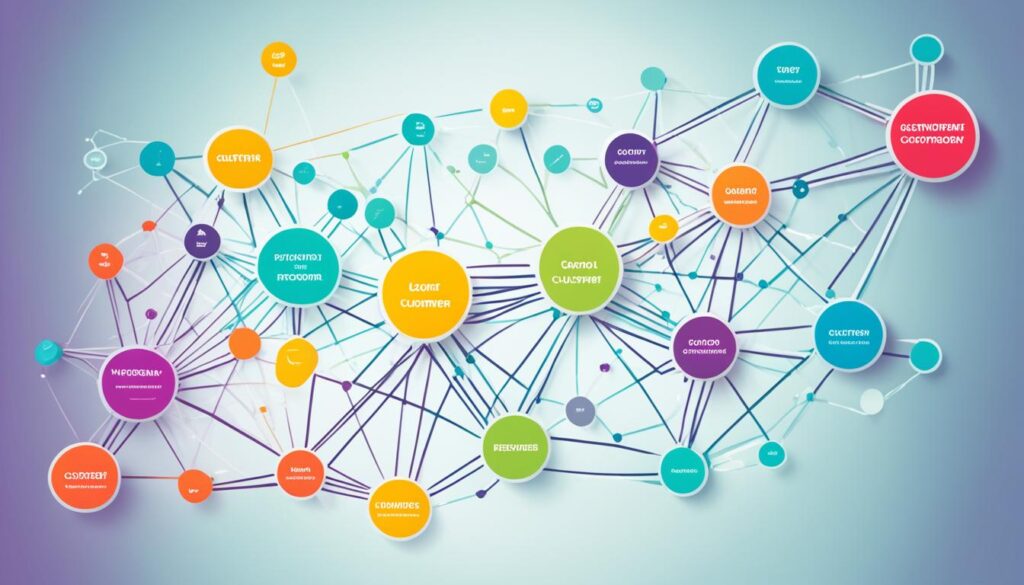Customer retention is a vital metric that measures customer loyalty and plays a significant role in the success of your business. It is well-known that retaining existing customers is more cost-effective than acquiring new ones. By implementing effective customer retention strategies, you can boost loyalty and pave the way for long-term success.
To calculate the customer retention rate, divide the total number of customers at the end of a period by the number of customers acquired at the beginning of the same period. This rate helps you assess your success in retaining customers and identifying areas for improvement.
In this article, we will explore proven techniques and customer loyalty strategies to help you enhance customer retention and achieve sustainable growth. Let’s dive in!
What is Customer Retention?
Customer retention is a vital metric used to measure customer loyalty and determine the overall success of a business. It refers to the strategies and efforts undertaken to reduce customer churn and improve customer experiences, ultimately ensuring their long-term loyalty. By retaining existing customers, businesses can save on acquisition costs and maximize their profitability. To gauge customer retention, one commonly used metric is the customer retention rate.
How to Calculate Customer Retention Rate
The customer retention rate is calculated by dividing the total number of customers at the end of a specific period by the number of customers acquired at the beginning of that same period. It provides valuable insights into how successfully a business is retaining its customers over time. By monitoring and analyzing this rate, businesses can understand their customer retention performance and identify areas for improvement.

Why Customer Retention Matters
Customer retention is a critical component of sustainable business growth. It allows companies to build strong and lasting relationships with their customer base, leading to increased profitability and brand loyalty. Moreover, loyal customers often become advocates for the brand, bringing in new customers through positive word-of-mouth recommendations.
The customer retention rate is a valuable indicator of customer satisfaction and overall business health. By enhancing customer retention strategies, businesses can increase customer loyalty, drive revenue growth, and gain a competitive advantage in the market.
With a clear understanding of what customer retention is and how to calculate the customer retention rate, businesses can start implementing effective strategies to improve customer loyalty and ensure long-term success.
How to Retain Customers
To retain customers and foster long-term relationships, businesses can implement a variety of effective customer retention strategies. By focusing on customer onboarding, personalized experiences, and maintaining a strong customer feedback loop, companies can increase customer satisfaction and loyalty. Additionally, staying connected with customers through regular communication plays a crucial role in maximizing customer retention rates.
Creating a Strong Onboarding Experience
When it comes to retaining customers, leaving a positive first impression is essential. By creating a strong onboarding experience, businesses can set the foundation for long-term customer satisfaction. A well-designed onboarding process helps customers understand your product or service, showcases its value, and addresses any initial concerns or questions. This ensures that customers feel confident and supported right from the start, increasing the likelihood of their continued engagement.
Providing Personalized Customer Experiences
Personalization is a key factor in improving customer satisfaction and retention. Today’s customers value tailored experiences that cater to their unique needs and preferences. By leveraging customer data and implementing personalized marketing strategies, businesses can deliver targeted offers, recommendations, and messaging that resonate with individual customers. This not only enhances their overall experience but also strengthens their connection to your brand.
Implementing a Customer Feedback Loop
A customer feedback loop is an essential tool for gathering insights and continuously improving your products or services. By actively collecting and analyzing customer feedback through surveys, reviews, and other channels, businesses can identify areas for enhancement and address any potential issues proactively. This iterative process of feedback and improvement demonstrates your commitment to meeting customer needs and leads to higher satisfaction and loyalty.
Maintaining Customer Communication
Staying connected with customers is vital for building lasting relationships. By maintaining a customer communication calendar, businesses can regularly engage with their customer base and provide value-added touchpoints. Sending newsletters, product updates, and relevant industry information helps you stay top of mind and fosters a sense of community with your customers. This consistent communication showcases your commitment to their success and encourages continued engagement and loyalty.
| Customer Retention Strategies | Benefits |
|---|---|
| Strong Onboarding Experience | – Creates a positive first impression – Builds trust and confidence |
| Personalized Customer Experiences | – Enhances customer satisfaction – Increases brand loyalty |
| Customer Feedback Loop | – Drives continuous improvement – Addresses customer concerns |
| Maintaining Customer Communication | – Fosters engagement and loyalty – Builds long-term relationships |
Building Trust with Customers
Building trust with customers is essential for fostering long-term relationships and improving customer retention rates. Trust is not built overnight, but through consistent delivery of value and a commitment to fulfilling brand promises. When customers trust a brand, they are more likely to remain loyal and continue engaging with its products or services.
Customers value reliability and want to feel confident in the strength and ability of a brand. They want to know that their needs will be met and their concerns will be addressed. By prioritizing customer satisfaction and consistently delivering on expectations, businesses can establish trust and credibility.
One way to build trust is by providing exceptional customer service. Responding promptly to inquiries, resolving issues efficiently, and offering personalized support creates a positive customer experience. Additionally, businesses can take steps to ensure the security and privacy of customer data, helping customers feel confident in sharing their information.
Transparency is another key factor in building trust. Being open and honest about policies, pricing, and any potential limitations builds credibility. Sharing success stories, customer testimonials, and positive feedback can also help establish trust by showcasing the positive experiences of other customers.

“Trust is built when you consistently deliver value and follow through on your brand promises.”
Case Study: XYZ Company
“Maintaining open and transparent communication with our customers has been crucial in building trust. By promptly addressing their concerns and valuing their feedback, we’ve established strong relationships based on reliability and transparency. This has not only helped in building a loyal customer base but has also increased brand credibility.”
In summary, building trust with customers is a continuous effort that requires consistent delivery of value, exceptional customer service, transparency, and open communication. By prioritizing customer trust, businesses can enhance customer retention rates and foster long-term relationships.
| Benefits of Building Trust with Customers | Strategies to Build Trust |
|---|---|
| 1. Increased customer loyalty | 1. Provide exceptional customer service |
| 2. Higher customer retention rates | 2. Ensure security and privacy of customer data |
| 3. Positive word-of-mouth recommendations | 3. Be transparent about policies and pricing |
| 4. Enhanced brand credibility | 4. Share success stories and customer testimonials |
Unique Services and Customer Retention Programs
Offering unique services that solve specific customer pain points and needs can significantly contribute to customer retention. When customers find a brand that provides superior products or services compared to competitors, they are more likely to commit and stay loyal. To ensure long-term success, starting a customer retention program is essential.
A customer retention program can be tailored to different business cases and involve various tactics to retain customers effectively. These programs focus on creating a positive customer experience at every touchpoint, from the initial purchase to ongoing support and engagement. By implementing a customer education program as part of the retention strategy, businesses demonstrate a long-term investment in customer satisfaction and retention.
The Benefits of Unique Services
Providing unique services sets your brand apart from competitors and gives customers a compelling reason to choose and stick with your business. Here are some key benefits:
- Increased Customer Satisfaction: Unique services address specific pain points, allowing customers to receive tailored solutions and experiences. This leads to higher customer satisfaction and a deeper emotional connection with your brand.
- Enhanced Brand Differentiation: Unique services differentiate your brand in the market, making it more compelling and memorable. When customers have access to something they can’t find elsewhere, they are more likely to remain loyal and recommend your brand to others.
- Improved Customer Retention: Offering unique services that address customer needs and deliver exceptional value significantly increases customer retention rates. By consistently exceeding customer expectations, you create a loyal customer base that continues to choose your brand over competitors.
Implementing a Customer Retention Program
A customer retention program is a strategic initiative aimed at maximizing customer retention rates and fostering long-term relationships. It involves implementing various tactics and strategies to engage, delight, and retain customers. Here are some key components:
- Customer Onboarding: Creating a strong onboarding experience for new customers sets the foundation for a positive long-term relationship. Provide clear instructions, assistance, and resources to help customers understand and get the most out of your products or services right from the start.
- Personalized Customer Experiences: Tailor your interactions, offers, and communications to each customer’s preferences and needs. Use customer data and insights to provide personalized recommendations, exclusive offers, and targeted content that resonates with their interests.
- Customer Feedback Loop: Implement a system for collecting and analyzing customer feedback. Actively listen to your customers’ opinions, concerns, and suggestions. Use this feedback to enhance your products, services, and overall customer experience continually.
Remember, a customer retention program should be continuously monitored, evaluated, and optimized based on evolving customer needs and market trends.

| Key Elements of a Customer Retention Program | Benefits |
|---|---|
| Customer Onboarding | Establishes a strong foundation for customer loyalty and satisfaction |
| Personalized Customer Experiences | Increases customer engagement, loyalty, and lifetime value |
| Customer Feedback Loop | Aids in identifying areas for improvement and enhancing customer satisfaction |
Conclusion
Implementing effective customer retention strategies is crucial for businesses to boost loyalty and improve customer retention rates. By focusing on retaining existing customers rather than solely acquiring new ones, businesses can achieve sustainable growth and increased profitability.
To enhance customer retention, it is essential to start with a strong onboarding experience that leaves a positive first impression. Customizing and personalizing customer experiences based on individual needs and preferences further contributes to higher satisfaction levels.
Building trust is another vital aspect of improving customer retention rates. By consistently delivering value and following through on brand promises, businesses can foster long-term relationships and ensure customer loyalty.
Additionally, implementing customer retention programs and offering unique services that address specific customer pain points and needs contribute to customer satisfaction and retention. Regularly collecting customer feedback, maintaining open communication, and offering continuous support further enhance the overall customer experience.
By employing these customer retention strategies and continuously seeking to improve, businesses can strengthen customer satisfaction, foster loyalty, and achieve long-term success.
FAQ
What is customer retention?
Customer retention is a metric that measures customer loyalty over time. It involves reducing the number of customers lost and improving their experiences to ensure their loyalty.
How do you calculate customer retention rate?
To calculate the customer retention rate, divide the total number of customers at the end of a period by the number of customers acquired at the beginning of the period. This helps businesses understand their success in retaining customers and identify areas for improvement.
How can I retain customers?
To retain customers, you can implement various strategies such as creating a strong onboarding experience, providing personalized customer experiences, and implementing a customer feedback loop. These techniques help improve satisfaction and foster long-term relationships.
How do I build trust with customers?
Trust is built over time by consistently delivering value and following through on brand promises. Customers value reliability and want to feel confident in the strength and ability of a brand. By maintaining trust, businesses increase the likelihood of retaining customers and fostering long-term relationships.
How do unique services and customer retention programs contribute to customer retention?
Offering unique services that solve specific customer pain points and needs can contribute to customer retention. Additionally, implementing customer retention programs tailored to different business cases and involving various tactics help retain customers. These programs, along with customer education initiatives, demonstrate a long-term investment in customer satisfaction and retention.
